Road Safety Rules and Regulations Notes 8th Social Science
Road Safety Rules and Regulations Notes 8th Social Science
8th Social Science Lesson 17 Notes in English
17. Road Safety Rules and Regulations
Introduction
- Our entire civilization has been based upon some of our extraordinary infrastructures which give us speed and connectivity.
- The roads are one of the most crucial inventions of man. In today’s world transport has become an integral part of every human being.
- Roads minimises the distance but on the other hand road accidents injures lakhs of people and results in loss of lives.
- Road safety is primarily meant about to protect and provide security of all those who travel on roads.
Importance of Road Safety
- Every day the newspapers report of accidents of road and mishaps occurring frequently. Road accidents are undesired events that lead to injury or death.
- These deaths and injuries result in significant social and economic costs.
- The problem does not lie with roads; it is our carelessness that results in such misfortune. The loss of life results in the loss of livelihood.
- Our traffic is a heterogeneous mix of slow moving as well as high-speed vehicles which is the cause for the problem.
Direct Consequences of Accidents: Fatality (death), Injury, Property damage.
Reasons for the Road Accidents
Over Speeding
- The higher the speed greater the risk. Most of the fatal accidents occur due to over speeding.
- Increase in speed multiplies the risk of accident and severity of injury during an accident. Tailgating is illegal and dangerous habit. (driving too close behind a vehicle)
Drunken Driving
- Consumption of alcohol reduces concentration. It hampers vision due to dizziness.
- And driving under the influence of alcohol causes accidents. (Random breath test is done to detect consumption of alcohol)
Distraction to Drivers
- Distraction could be outside or inside the vehicle.
- The Major distraction now a days is talking on mobile phones while driving.
- The act of talking on phone occupies a major portion of the brain’s function and the smaller part handles the driving skills.
- Some other distractions are inattentive or lost in thought (daydreaming), adjusting mirrors while driving, stereo in vehicle, animals on road, banners and billboards etc.
8th Social Book Back Questions
Red Light Jumping
- The main motive behind red light jumping is saving time.
- Studies have shown that traffic signals followed properly by all the drivers save time and commuters reach destination safely and on time.
Avoiding Safety Gears
- Use of seat belt in four wheelers and helmets for two wheelers have been brought under law.
- These two things reduce the severity of injury during accidents.
Other different factors
Drivers – over speeding, rash driving, violation of rules, failure to understand signs, fatigue and consumption of alcohol.
Pedestrian – carelessness, illiteracy, crossing at wrong places, moving on roads and jaywalkers.
Passengers – projecting their body outside the vehicle, by talking to drivers, travelling on footboards, catching a running bus etc.
Vehicles – failure of brakes or steering, tyre burst, insufficient headlights, overloading and projecting loads.
Road Condition – damaged road, potholes, eroded road merging of rural road with highways, diversion and illegal speed breakers
Weather Conditions – fog, snow, heavy rainfall, wind, storms and hail storms.
Safety Measures
- Always keep to the left – While driving, keep to the left and allow vehicles to pass from the opposite direction.
- Slow down on bends and turn – A very important thing to keep in mind is to become cautious and slow down on the bends.
- Use helmets – Make it a habit of strapping the helmet before mounting the bikes.
- Never exceed the speed limit – The speed limit is related to the traffic condition of the area. So maintain speed limit.
- Maintain the right distance – Collisions occur because we do not maintain adequate distance from the vehicle in the front. So maintain a safe distance from the bigger vehicles. Keep out of their blind spot (an area not seen through the rear view and wing mirror)
- Park the vehicles only along the designated parking bays/zones not on the sides of the high ways. Use parking lights and caution triangle while attending breakdown.
- Follow the road signs – Road signs are mostly pictorial so it is not hard to comprehend.
- Some other safety tips are – Never ever drive when drunk, never use cell phone while driving, avoid listening to too loud music, check your mirrors before changing lanes, always wear seat belts, always remain calm while driving and never yell or shout at pedestrian or other drivers.
- For pedestrians – Cross only at zebra crossing. The two minutes’ time that you waste for the signals are worth your life. Never cross on red and yellow light. Take a sidewalk and avoid walking on the roads.
Mandatory Signs
The first category of traffic signs is mandatory signs. Violation of any mandatory traffic sign is an offence punishable by law by the Roadways and Transport Department.
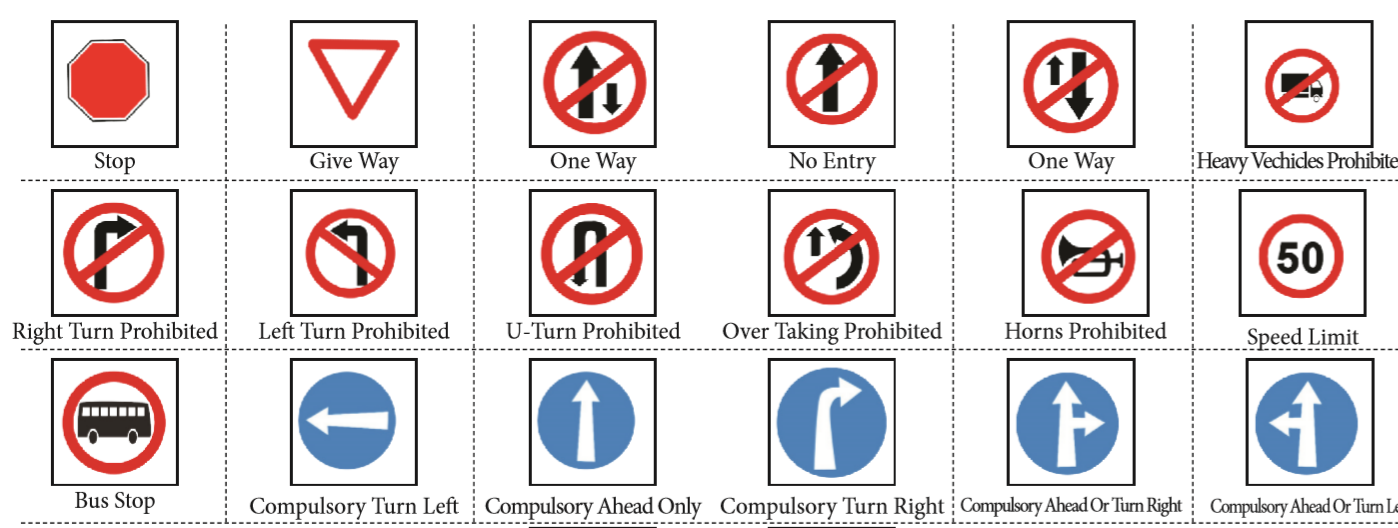
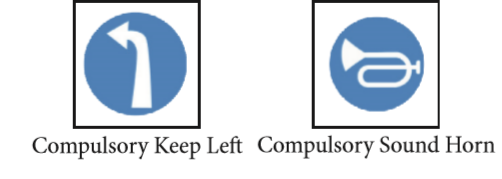
Cautionary Signs
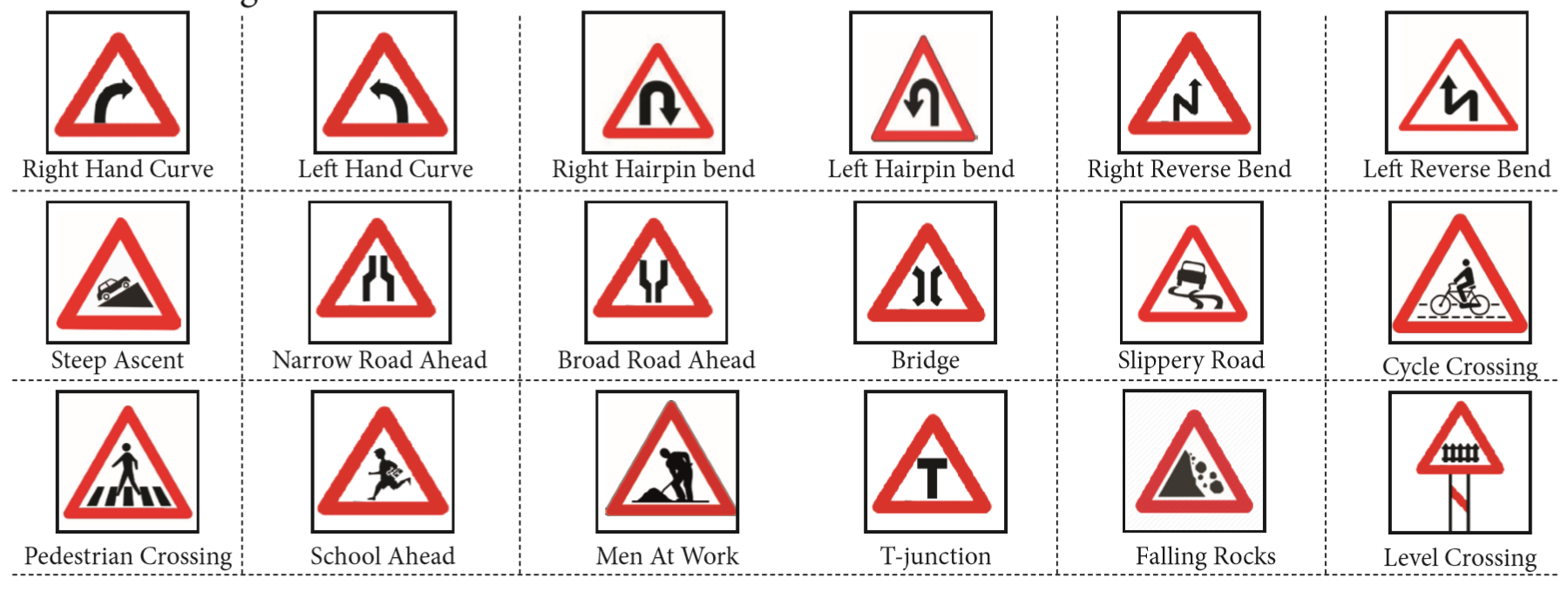
- A total of 40 cautionary traffic signs have been added by the Roadways and Transport Department.
- The main function of cautionary signs is to warn the driver to take necessary action to manage the situation.
Informatory Signs
These signs provide information to the drivers via boards.

Traffic Signs
- Traffic signs are there to regulate traffic, warn about hazards and to guide the road users.
- Understanding traffic signs is essential. We should have a proper knowledge of traffic signs.
- The government has made it mandatory for a person who wants to obtain driving license to be well versed with the traffic signs.
- Traffic signs prevent the undesirable risks posed on the road to drivers and passengers in the vehicle. There are three types of traffic signs.
- Mandatory Signs – give order and need to be followed strictly. They are generally in circular in shape.
- Cautionary Signs – warn the user regarding road situation ahead. They are generally, in triangular shape.
- Informatory signs – give information regarding directions, destinations, etc., They are generally in rectangular shape.
Traffic Signals
- Traffic lights is a signalling device that is positioned at a road intersection, pedestrian crossing to indicate when it is safe to drive, ride or walk using a universal colour code.
- Red – this signal indicates to stop behind the stop line.
- Amber (Yellow) – this signal indicates stop. Do not pass through or start until green shows. If, by mistake, you are caught in yellow signal in the middle of a large road crossing, continue with care and do not accelerate in panic.
- Green – this signal indicates you may go if the way is clear.
- Steady Green Arrow Signal – this signal may be provided in addition to the full green signal. This indicates to proceed with caution in the direction the arrow points.
- Flashing Red Signal – it means to come to complete stop. Proceed only when the way is clear.
- Flashing Yellow Signal – it indicates to slow down and proceed with caution.
Traffic Rules in India
The Motor Vehicle Act 1988 passed by the Parliament which came into force in 1989 is applicable to the whole of India.
- On one-way road the driver should allow the overtaking vehicle through the right. Never park the vehicle in reverse on a one-way street.
- On a two-way road, the driver must drive on the left side of the road.
- It is mandatory for the driver to slow down at all inter junctions and pedestrian crossing.
- Drivers should not use the horns in prohibited areas like hospital zones, school zones etc.
- It is our responsibility to give way to emergency vehicles such as Army convoy fire engine and ambulance.
- Driver should use high – beam only when necessary. It is important to dim the lights when there are oncoming vehicles or when driving closely behind another.
- When the driver is slowing down his vehicle, he has to raise the right arm and swing it up and down gently.
- When the driver stopping his vehicle he has to raise the arm vertically for the indication to the other vehicles behind it.
- If the driver is turning right, he has to extend the arm straight out with the palm facing front.
- If the driver is turning left, he has to rotate the hand in the anti-clockwise direction.
- In case of emergency, the hazard indicator should be used, which will switch on both the indicators.
- On a two-wheeler only one pillion rider is allowed.
- The horn should not sound really shrill irritating or loud. Electronic horn is permitted.
- Parking vehicles in front of rescue vehicles such as an ambulance, fire engine or a police vehicle is punishable by law and the individual doing so has to pay fine.
Different colour Number Plates

It is used in the vehicle for the President of India and Governor of States.
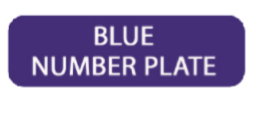
It is given to a vehicle that is used by foreign delegates/ ambassadors.
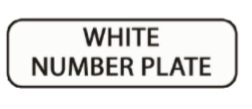
It means that the car belongs to a common citizen.

It is for commercial vehicle.
Essential Documents – A driver should possess the following documents while driving the vehicle: Driving License, Registration Certificate of the Vehicle, Taxation Certificate, Insurance Certificate, Fitness Certificate, and Permit.
Steps taken by the Government to prevent Road Accidents
The Ministry of Road Transport and Highways has taken a number of steps to prevent road accidents and road accident fatalities. These include:
- A multi – pronged strategy has been adopted based on four Es – Engineering, Enforcement, Education and Emergency care for ensuring road safety. They are meant to provide better and safer road engineering, improved vehicular safety standards, training of drivers, improved trauma care and creating public awareness.
- Improving Vehicular Safety Standards – Trucks are prohibited from carrying protruding rods.
- Anti – locking Brake System (ABS) has been made mandatory on heavy vehicles. Induction of ABS/CBS for two wheelers are made mandatory. AHO (Automatic Headlight On) made mandatory for two-wheelers to make them more conspicuous.
- Pilot Projects for Cashless Treatment of Road Accident Victims – This project has already done in the stretch of NH 8 and NH 33. Now it is proposed to implement this scheme along the Golden Quadrilateral, North South and East West Corridors. Quick response ambulances are parked in every 50 kms on the National Highways by the National Highway Authority of India (NHAI). A 24 x 7 call centre to receive calls for ambulances has been created and training has been given for providing first aid to road safety volunteers.
- Speed Governors – This device has a series of sensors that can detect how fast a vehicle is going and if this crosses the limit set by it,it restricts the flow of air and fuel to the engine. This automatically slows down and stops the vehicle from crossing the pre-determined speed.
- Variable Message Signs – These are LED boards which can display important information that needs to be communicated to commuters. These can be used to update road users the traffic conditions in case of major breakdowns, congestions and so on.
Brasilia Declaration on Road Safety
- It is the Second Global High level Conference on Road Safety co–sponsored by the WHO.
- Taking road safety as a serious issue, India signed Brasilia Declaration in 2015 through which the participants across the world are committed to improve road safety and ways to reduce the traffic deaths by the end of this decade.
- The Ministry of Road Transport and Highways has released a set of comic books on road safety called Swachha Safer and Suvarshit Yatra with the aim of creating awareness among children.
Road Safety Week
- Road safety week is a national event aimed at raising public awareness about traffic rules and ultimately to reduce casualties due to road accidents.
- It is also intented to reinforce road safety behaviour among road users.
- Celebrating the road safety campaign was initiated by the Ministry of Road Transport and Highways.
- National Road Safety Week in India is organised by the National Safety Council of India (NSC).
- It is an autonomous body set up by the Indian government to engage the public on safety, health and environment issues.
- National Road Safety Week is observed in the month of January every year.
Decade of Action for Road Safety 2011 – 2020
- Decade of Action for Road Safety 2011 -2020, officially proclaimed by the UN General Assembly.
- The decade seeks to save millions of lives by improving the safety of roads and vehicles, enhancing the behavior of road users and improving emergency services.
The international Federation of Red Cross and Red Crescent Societies (IFRC)
Suggested 10 points as follows
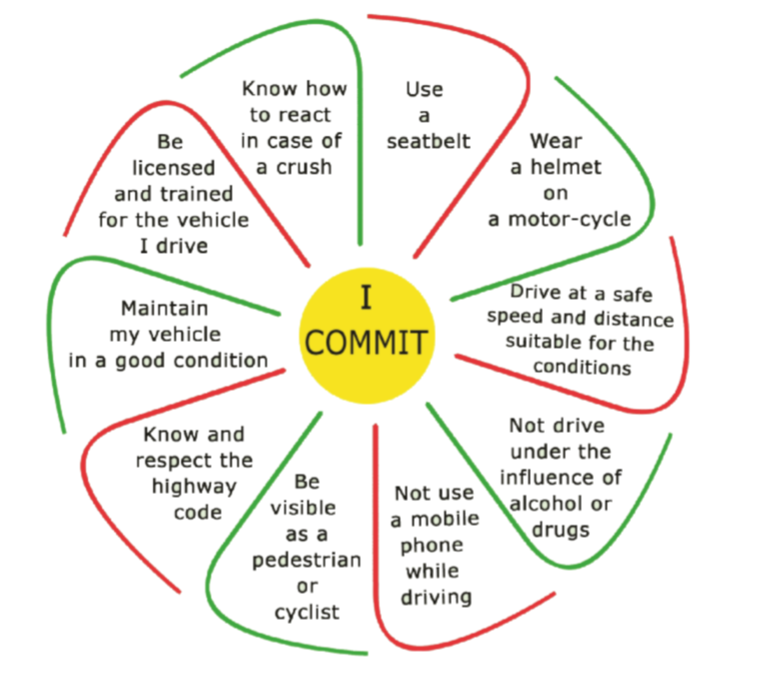
Conclusion
Road traffic accident are predictable and therefore preventable. So everyone should strictly follow the road safety rules and signs.
More to Know:
1. Save LIFE Foundation
Save LIFE Foundation is an independent, non-profit, non-governmental and public charitable trust that is working to improve road safety and emergency medical care across India.
2. Setu Bharatam
A program was launched in 2016 for building bridges for safe and seamless travel on National Highways. It aims to make all National Highways free of railway level crossing by 2019.
3. 304 A of the Indian Penal Code
The police will file a criminal case under this section, which deals with offences relating to death due to rashness and negligence of the driver.
4. Lights at Night:
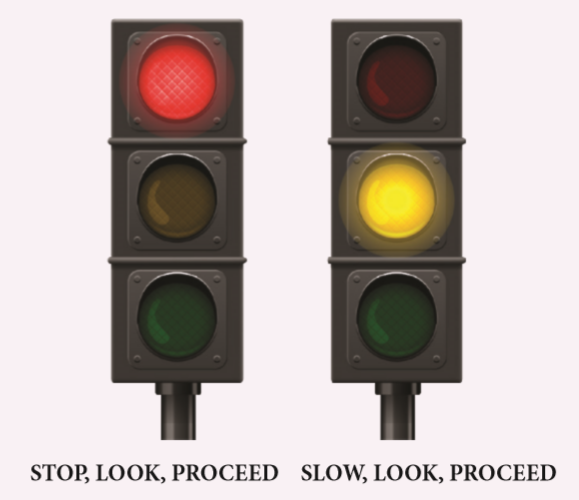
At night, when traffic has dwindled, the traffic police might switch off the signals in many intersections which means proceed with caution but no need to stop.
5. Broken white line – basic marking on roads. you may change lanes, and are allowed to overtake a vehicle or take U turn of it is safe to do so.

6. Solid white line – seen on areas of strategic importance. These implies that you are not allowed to overtake and to stay within the lane.

7. Single solid Yellow lines – used in areas where visibility is low. It implies that you can overtake And should drive on your side.

8. Double solid yellow lines – used on dangerous roads or for two-way traffic. It strictly prohibits anybody from crossing over into the lane. You can overtake inside your own lane.

9. Stop line – This is marked before the pedestrian crossing and sets the deadline where car shoud stop before traffic signal.

10. Solid and Broken lines – if you are driving on the side with the broken line you are allowed to overtake and if you are driving on the side of the solid line you are not.

11. The 108 Emergency Response Service
It is a free emergency service providing integrated medical (ambulance), police and fire services. If you find any victims on road don’t panic. Call 108 for help and 103 for traffic accidents.